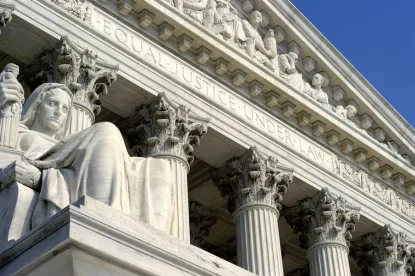Earlier this month, the United States Supreme Court unanimously rebuffed the Second Circuit’s attempt to expand the scope of res judicata to include the so-called concept of “defense preclusion” – a novel doctrine that would have barred defendants from raising defenses not asserted in previously adjudicated disputes regardless of whether the disputes share a common nucleus of operative fact. Lucky Brand Dungarees, Inc. v. Marcel Fashions Group, Inc..
The Second Circuit had set forth a four factor test to bar defenses where “(i) a previous action involved an adjudication on the merits”; “(ii) the previous action involved the same parties”; “(iii) the defense was either asserted or could have been asserted, in the prior action”; and “(iv) the district court, in its discretion, concludes that preclusion of the defense is appropriate.” Marcel Fashions Grp., Inc. v. Lucky Brand Dungarees, Inc., et al.. The elements of this test are familiar enough, drawing inspiration from decades of res judicata precedent (also known as claim preclusion and issue preclusion), but with two glaring differences: (1) issue preclusion bars only what was “actually litigated and resolved,” not what simply was “asserted or could have been asserted” (Taylor v. Sturgell); and (2) claim preclusion bars successive causes of action, whether previously asserted or not, only to the extent they concern a “common nucleus of operative fact” (Currier v. Virginia). The Second Circuit’s conception of the defense preclusion test slid between these two hallmarks of res judicata purporting, on its face, to permit preclusion by judicial whim of previously unasserted arguments in cases that were factually distinct.
The Supreme Court rejected the Second Circuit’s formulation. One of the most curious takeaways from its opinion is that it strikes down the Second Circuit’s test without uttering the words “due process”—which, in the words of the Taylor Court, is “of course” a limitation on the federal common law of preclusion. 553 U.S. at 891. The absence of this concept from the Court’s reasoning would be less striking, if it were not for its invitation (at n2) extended to courts and active plaintiffs to take a second stab at the defense preclusion doctrine. Thus, the Court gratuitously avoided foreclosing the availability of defense preclusion, as a form of claim preclusion, in the future. But if the claim at issue is not precluded (because, for example, it has not already been litigated to conclusion), it is difficult to fathom circumstances in which it would be appropriate, or consistent with due process, to foreclose defenses that were not previously raised and actually litigated (i.e., defenses that meet the requirements of issue preclusion). Nevertheless, it appears that the Supreme Court is willing to consider new judge-made rules on that subject.



 />i
/>i

